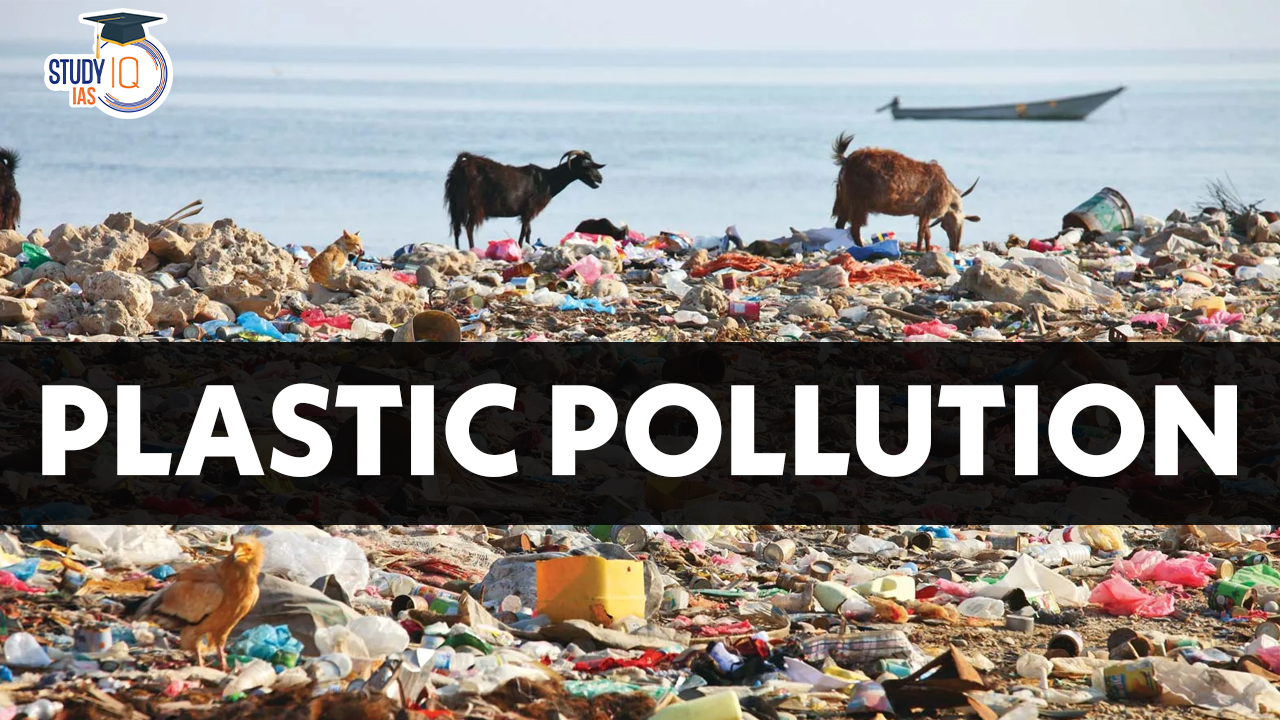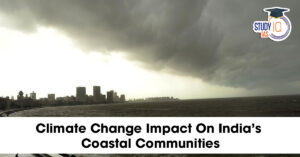Table of Contents
Context: The Organisation for Economic Co-operation and Development (OECD) released an interim report (titled “Towards Eliminating Plastic Pollution by 2040: A Policy Scenario Analysis”)
Key Findings of the OECD Report
- By 2040, it’s expected that the release of microplastics into the environment will increase by 50% compared to the climate policies of 2021.
- However, early, rigorous, and coordinated global policy efforts, costing just 0.5% of global GDP, could cut plastic waste generation by a quarter of the current forecasts for 2040.
- To effectively address plastic waste issues, reducing production and demand through taxes, regulations, and promoting sustainable alternatives is vital.
- Additionally, improving the design of plastic products for better reusability and developing more efficient recycling techniques are essential.
- Enhancing waste collection and disposal methods is also key to preventing plastic waste from polluting the environment.
We’re now on WhatsApp. Click to Join
Negative Effects of Persistent Plastic Usage and Waste
- Environmental Damage: Oceanic plastic accumulation damages marine life, and ecosystem imbalances due to plastic pollution.
- Climate Change: Plastic production contributes to greenhouse gas emissions, and recycling processes are energy-heavy.
- Health Risks: Microplastics in the food chain impact human health and respiratory problems from burning plastic.
- Economic Costs: Expenses in cleaning up plastic litter, and decreased tourism in polluted areas.
- Impact on Wildlife: Animals consuming plastic face lethal risks, and wildlife entanglement in plastic waste.
- Resource Consumption: Fossil fuel usage in making plastics, strain on raw materials for production.
Efforts to Combat Microplastics
Global Actions
- Global Partnership on Marine Litter (GPML): Tackles marine litter globally.
- GloLitter Partnerships Project: Focuses on reducing litter from maritime activities.
- London Convention (1972): Regulates dumping into the seas.
India’s Initiatives
- Single-use Plastic Ban: Aims to eliminate single-use plastics.
- Plastic Waste Management Rules (2016): Regulates plastic waste handling.
- Un-Plastic Collective: Encourages plastic waste reduction.
- Kerala’s Beat Plastic Pollution Initiative: State-level effort against plastic pollution.
International Approaches to Single-use Plastic:
- UN Resolution: 124 countries, including India, agreed to formulate a legally binding agreement covering the entire lifecycle of plastics to curb pollution.
- Bag Bans: 68 countries enforce plastic bag bans.
- Bangladesh: First to ban thin plastic bags in 2002.
- China: Implemented a phased plastic bag ban in 2020.
- European Union: Prohibits certain single-use plastics with available alternatives.
Check here all about Plastic Pollution, its sources, types of Plastic Waste, impact of Plastic Pollution and many more.
What is Plastic Pollution?
- Plastic is a synthetic organic polymer made from petroleum with properties ideally suited for a wide variety of applications, including packaging, building and construction, household, electronics, agriculture etc.
- It is non-biodegradable in nature and persists in the environment, for hundreds or even thousands) of years.
- Plastic pollution is caused by the accumulation of this plastic waste in the environment.
- It can be categorized as primary plastic wastes such as cigarette butts and bottle caps, or secondary plastic wastes that are formed by the degradation of the primary ones.
- As per the UN, over 300 million tons of plastic are produced every year and India generates 46 million tonnes of plastic waste annually, of which 40% remains uncollected and 43% is used for packaging, most of which are of single-use plastic.

Sources of Plastic Pollution
- The main sources of marine plastic are land-based, from urban and storm runoff, sewer overflows, beach visitors, inadequate waste disposal and management, industrial activities, construction and illegal dumping.
- Ocean-based plastic originates mainly from the fishing industry, nautical activities and aquaculture.
- Under the influence of solar UV radiation, wind, currents and other natural factors, plastic fragments into small particles, termed microplastics (particles smaller than 5 mm) or nanoplastics (particles smaller than 100 nm).
Types of Plastic Waste
- Microplastics are small plastic pieces of less than five millimetres in size.
- Microplastic includes microbeads (solid plastic particles of less than one millimetre in their largest dimension) that are used in cosmetics and personal care products, industrial scrubbers which are used for aggressive blast cleaning, microfibers used in textiles and virgin resin pellets used in plastic manufacturing processes.
- Single-use plastic is a disposable material that can be used only once before it is either thrown away or recycled, plastic bags, water bottles, soda bottles, straws, plastic plates, cups, most food packaging and coffee stirrers are sources of single-use plastic.
- India has announced its commitment to eliminate single-use plastic by 2022 at the Confederation of Indian Industry’s Sustainability Summit in New Delhi.
Threats/Impact of Plastic Pollution
- Economic Losses: Plastic waste along the shoreline has a negative impact on tourism revenue (creates an aesthetic issue). For example, the Andaman and Nicobar Islands are facing aesthetic issues because of the international dumping of plastic waste on the island.
- Impact on Animals: Plastic wastes have profoundly affected animals in aquatic, marine, and terrestrial ecosystems. Plastic ingestion upsets or fills up the digestive systems of the animals thus contributing to their death due to intestinal blockage or starvation.
- Impact on Human Health: The chemicals leached from the plastics contain compounds, like polybrominated diphenyl ether (anti-androgen), bisphenol A (mimics the natural female hormone estrogen) and phthalates (also known as anti-androgens), which impact human health leading to various hormonal and genetic disorders.
- Land Pollution: Plastics leach hazardous chemicals onto land, resulting in the destruction and decline in quality of the earth’s land surfaces in terms of use, landscape and ability to support life forms.
- Air Pollution: Plastic burning releases poisonous chemicals into the atmosphere impacting general well-being and causing respiratory disorders in living beings.
- Groundwater Pollution: Whenever plastics are dumped in landfills, the hazardous chemicals present in them seep underground when it rains. The leaching chemicals and toxic elements infiltrate into the aquifers and water table, indirectly affecting groundwater quality.
- Water Pollution: In 2014, a United Nations report estimated the annual impact of plastic pollution on oceans at US$ 13 billion.
- Interference with the Food Chain: When the smaller animals (planktons, molluscs, worms, fishes, insects, and amphibians) are intoxicated by ingesting plastic, they are passed on to the larger animals disrupting the interrelated connections within the food chain.
Shortcomings in Handling Plastic Pollution in India
- Weak waste management systems: Lagging to meet the growing needs.
- Insufficient data and reporting: The products are scattered into diverse sectors.
- Use of Single-Use Plastics which has short lifespan and widespread use.
- Poor implementation of policies: Like Plastic Waste Management Amendment Rules, 2021.
- Consumer behaviour: This is currently aligned with the usage of plastic disposables.
- Lack of a suitable alternative: which is either too costly or difficult to produce in mass.
Initiatives to Combat Plastic Pollution
Global Initiatives
- The 1972 Convention on the Prevention of Marine Pollution by Dumping Wastes and Other Matter (or the London Convention).
- The 1996 Protocol to the London Convention (the London Protocol).
- The 1978 Protocol to the International Convention for the Prevention of Pollution from Ships (MARPOL).
- The United Nations Environment Program (UNEP) considers plastic marine debris and its ability to transport harmful substances as one of the main emerging issues affecting the environment.
- GloLitter Partnerships (GLP): It is a project launched by the International Maritime Organization (IMO) and the Food and Agriculture Organization of the United Nations (FAO) and initial funding from the Government of Norway.
- Clean Seas Campaign:
- The United Nations Environment Programme launched the Clean Seas Campaign in 2017 to reduce the use of unnecessary, avoidable and problematic plastics including single-use plastics and phase out intentionally added microplastics.
- The Campaign contributes to the goals of the Global Partnership on Marine Litter and the New Plastics Economy Global Commitment.
- UNEA’s Resolution to “End Plastic Pollution”: 175 countries have endorsed the UN Environment Assembly (UNEA-5) resolution in Nairobi to End Plastic Pollution and forge an international legally binding agreement by 2024.
Indian Initiatives
- The Plastic Waste Management Rules, 2016 clearly stipulate that urban local bodies (ULBs) should ban less than 50 micron thick plastic bags and not allow the usage of recycled plastics for packing food, beverages or any other eatables.
- The Rules also require that local bodies should provide separate collection, storage and processing of plastic waste in their areas.
- Plastic Waste Management (Amendment) Rules, 2021:
- Prohibits the manufacture, import, stocking, distribution, sale and use of single-use plastics.
- The thickness of plastic carry bags increased from 50 to 75 microns from 30th September 2021 and to 120 microns with effect from 31st December 2022.
- Extended Producer Responsibility guidelines made applicable to plastic producers.
- India is a signatory to MARPOL (International Convention on Prevention of Marine Pollution).
- Plastic Waste Management (Amendment) Rules, 2022: To strengthen the circular economy of plastic packaging waste and development of recycling infrastructure for plastic packaging waste.
- India Plastic Pact: It is the first of its kind in Asia. The Plastics Pact is an ambitious and collaborative initiative to bring stakeholders together to reduce, reuse and recycle plastics within the material’s value chain.
Way Forward
- Incentivize Recycling: Offer incentives for plastic recycling and recovery.
- Raise Awareness: Educate the public about plastic pollution’s impact.
- Enforce Regulations: Strengthen enforcement of plastic pollution rules.
- Empower Pollution Control: Enhance Pollution Control Board’s capabilities.
- Circular Economy: Implement circular economy practices for plastics.
- Identify Hotspots: Pinpoint plastic leakage areas for targeted action.
- Promote Alternatives: Replace plastics with recyclable or biodegradable materials.
- Oxo-Biodegradable Plastics: Encourage faster biodegradation plastics.
- Plastic-Eating Bacteria: Harness plastic-digesting bacteria for waste reduction.
- Recycling Innovation: Develop technologies like plastic-based tiles.
- Plastic-Free Workplaces: Ban single-use plastics in workplaces.
- Collaboration: Engage government, industry, NGOs, and volunteers.


 Marlin Fish: Species, Features, Appearan...
Marlin Fish: Species, Features, Appearan...
 Great Hornbill (Buceros bicornis): Habit...
Great Hornbill (Buceros bicornis): Habit...
 Climate Change Impact On India’s Coast...
Climate Change Impact On India’s Coast...





















